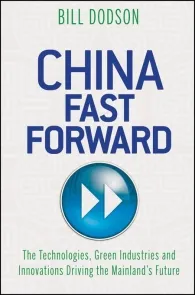[Book Review] China Fast Forward: The Technologies, Green Industries and Innovations Driving the Mainland’s Future

- by Bill Dodson (Amazon)
2012 John Wiley
10 chapters, 231 pages
Books about China (almost all English books about China seem to be by Westerners) usually fall into two types – those gushing endlessly about the might of the new superpower, or those predicting its imminent demise. This balanced book by Bill Dodson certainly captures the scale of China’s ambitious (even audacious) economic moves, while also throwing light on its shortcomings.
This book is a must-read for all those involved in the study and implementation of innovation ecosystems, not just in China but in the West and other giant emerging economies such as India (indeed, comparisons of the technology and innovation paths of China and India abound in the book). The book also invites other similar research and comparisons for big emerging economies such as India, Indonesia, Brasil, Russia, Nigeria and South Africa.
Bill Dodson has spent over a decade in China, and is also the author of China Inside Out. He is a graduate of Cornell University, and a prolific columnist on economics and industry issues for the China Economic Review. Dodson is a principal at TrendsAsia, a Shanghai-based investment analysis firm, and is an active blogger and tweeter.
The environmental challenges posed by China's vast manufacturing sector have been well documented in the media, but this book shows that China is also outstripping the West in all manner of green initiatives, renewable energy investments, research and development funding. The steps that China can take to increase urbanisation and manufacturing while also reducing pollution levels, excessive reliance on fossil fuels, and toxic waste products will be beneficial not only to this giant economy but the rest of the world as well, thanks to China’s economic prowess and global ambitions.
Though nervous about some of the political freedoms that accompany digital media, China has nonetheless adapted the Internet and mobile platforms for domestic use, with a range of Internet giants and startups. It also aims to rival India as a global services outsourcing leader, and create market leadership in consumer and industrial goods.
Challenges arise for China, however, in quality issues, security of infrastructure, human resource limitations, labour unrest, governance, accountability, intellectual property rights, human rights, and an ageing society. A delicate balance for China to find will be between scalability and sustainability, and the rest of the world has much to learn from China’s journey.
The author effectively describes China’s goals and roadmaps on the fast track to becoming a superpower, but also flags down the horror stories from tainted food to railroad disasters. Unfortunately, the Chinese approach to innovation (“indigenous innovation with Chinese characteristics”) often relies heavily on reverse-engineering foreign technologies and then exporting them as Chinese innovations, rather than encouraging domestic creativity, according to Dodson.
“The country is meeting global challenges on a scale that few nations can match,” says Dodson, and the global comunity must acknowledge that China's successes and failures hold important lessons for us all.
The material is extensively researched and well-presented, with a blend of cited references, on-the-ground reporting and analytical frameworks. The book is divided into 10 chapters covering the Internet, services industries, traditional and alternative energy, environmental impacts, and civil society. More material on mobile communications, healthcare (including indigenous health traditions), agri-tech, and the entertainment sector would have helped, but perhaps that is the topic of another book!
The book begins by showing how the Wenzhou Highspeed-Train accident in July 2011 literally put a brake on the speed of the country’s economic planning, and put issues of quality and safety on the same priority as quantity and speed of production.
In historical context, the West and China both had three ‘hard ceilings’ in history, but it was the Europeans who seized the technology advantage in the 17th century. Not to be daunted, 21st century China has launched major initiatives for innovation (2006) and patenting (2010). However, checks and balances for authenticity and quality are strongly needed in scientific research; innovations need to be more original and breakthrough rather than incremental or lateral. Deeper changes are needed in the “soul-crushing weight of its conformist approach to education and socialisation.”
In contrast, India does not force foreign technology companies into joint ventures with domestic companies for the sole aim of transferring technologies. Indian units of multinationals earn more patents than their Chinese counterparts. China has launched many tech parks to target the BPO, IT services and offshore R&D markets, but will find it hard to match India’s lead thanks to its advantage during Y2K, English language skills, and openness to Western management styles and culture. China’s BPO industry is more fragmented, and focused more on Japan and South Korea for reasons of cultural affinity and geographic proximity. Indeed, Indian IT services firms with a local presence in China are doing better than their local competitors.
Though China has a vibrant e-commerce marketplace, political constraints on free expression make for a ‘fractured Web.’ Sites like Facebook, YouTube and Twitter are blocked, and though China has home-grown knock-offs of such services, this hampers local innovation in broader global media properties and shackles many Chinese startups to the domestic marketplace (though some Chinese players make the most of a lack of Western competition in the domestic Internet arena!).
At the same time, Dodson also cautions that merely chasing ‘money-spinning gadget innovation’ such as Apple-inspired digital tools will not solve the bigger problems facing China. This ‘designer approach’ to innovation will not create wealth on a large scale for China.
In sectors such as shipping, the Chinese manufacturing sector has unfortunately been hit by over-production and the global economic downturn; similar problems have hit the automotive sector. Though some Chinese products have faced quality import roadblocks in Europe, they have been exported to other developing regions such as Africa instead. ‘Brand China’ also needs a remake to overcome perceptions of fakes, knock-offs, cheap and lack of originality.
Four chapters provide in-depth coverage of energy and environmental issues. China plans to build dozens of new cities, but will also need to address issues of energy, water and food security, and pollution. By 2010, China was using half the world’s coal. It has focused on improving the efficiency of coal extraction while also searching for alternatives such as wind turbines, solar panels and other such innovations.
Indeed, in 2010 China also surpassed the US in the total amount of wind power capacity installed for use. China has embarked on massive production of photovoltaic cells as well, but its attempts to dam up rivers for hydro-energy has caused friction with some Asian neighbours.
Rampant pollution has also angered the population in many cities and villages, and China faces serious obstacles in not having protected rights of assembly, protests and free speech for its citizens. ‘Social’ and even spiritual innovation could be the biggest challenge for China in the 21st century.
Dodson draws on a range of other books such as Why the West Rules – For Now (by Ian Morris), The Collapse of Complex Societies (by Joseph Tainter), The Great Stagnation (by Tyler Cowen), Where Good Ideas Come From (by Steven Johnson), Adapt (by Tim Hartford), The Party (by Richard McGregor), Guns, Germs and Steel (by Jared Diamond) and Reinventing Discovery (by Michael Nelson).
Useful resources online include articles by Anil Gupta and Haiyan Wang, Jason Dean, Andrew Hupert, Jonathan Watts, Jin Zhu and reports on MSNBC.
In sum, Dodson argues that emerging economies such as China can make the most of the ‘low-hanging fruit’ of the Industrial Revolution only for a limited amount of time as they catch up with the West; they have to focus on incubating local talent, and improving flows of global knowledge across disciplines and boundaries while also respecting IP. Only such a scientific and sustainable renaissance of creative paradigms will help China meet its own massive challenges while uplifting the world at the same time.
[Follow YourStory's research director Madanmohan Rao on Twitter at @MadanRao ]


![[Book Review] China Fast Forward: The Technologies, Green Industries and Innovations Driving the Mainland’s Future](https://images.yourstory.com/cs/wordpress/2012/10/china-ff.jpg?mode=crop&crop=faces&ar=16%3A9&format=auto&w=1920&q=75)




